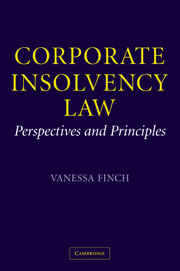Book contents
- Frontmatter
- Contents
- Acknowledgements
- Table of cases
- Table of statutes and other instruments
- List of abbreviations
- Introduction
- Part I Agendas and objectives
- 1 The roots of corporate insolvency law
- 2 Aims, objectives and benchmarks
- Part II The context of corporate insolvency law: financial and institutional
- Part III The quest for turnaround
- Part IV Gathering and distributing the assets
- Part V The impact of corporate insolvency
- Conclusion
- Bibliography
- Index
1 - The roots of corporate insolvency law
Published online by Cambridge University Press: 05 June 2012
- Frontmatter
- Contents
- Acknowledgements
- Table of cases
- Table of statutes and other instruments
- List of abbreviations
- Introduction
- Part I Agendas and objectives
- 1 The roots of corporate insolvency law
- 2 Aims, objectives and benchmarks
- Part II The context of corporate insolvency law: financial and institutional
- Part III The quest for turnaround
- Part IV Gathering and distributing the assets
- Part V The impact of corporate insolvency
- Conclusion
- Bibliography
- Index
Summary
In a society that facilitates the use of credit by companies there is a degree of risk that those who are owed money by a firm will suffer because the firm has become unable to pay its debts on the due date. If a number of creditors were owed money and all pursued the rights and remedies available to them (for example, contractual rights; rights to enforce security interests; rights to set off the debt against other obligations; proceedings for delivery, foreclosure or sale) a chaotic race to protect interests would take place and this might produce inefficiencies and unfairness. Huge costs would be incurred in pursuing individual creditors' claims competitively and (since in an insolvency there are insufficient assets to go round) those creditors who enforced their claim with most vigour and expertise would be paid but naïve latecomers would not.
A main aim of insolvency law is to replace this free-for-all with a legal regime in which creditors' rights and remedies are suspended and a process established for the orderly collection and realisation of the debtors' assets and the fair distribution of these according to creditors' claims. Part of the drama of insolvency law flows, accordingly, from its potentially having to unpack and reassemble what were seemingly concrete and clear legal rights.
- Type
- Chapter
- Information
- Corporate Insolvency LawPerspectives and Principles, pp. 7 - 24Publisher: Cambridge University PressPrint publication year: 2002



